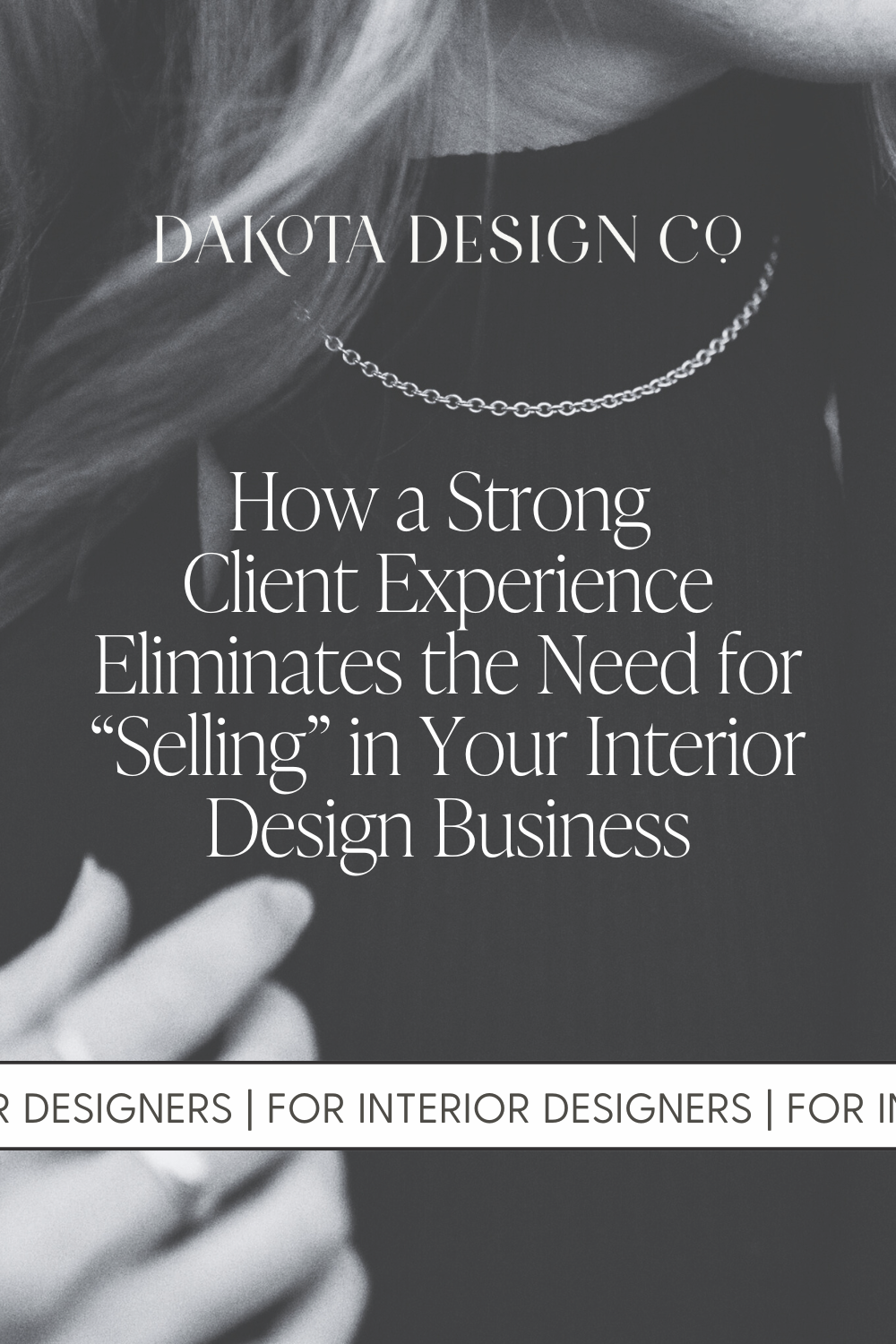How a Strong Client Experience Eliminates the Need for “Selling” in Your Interior Design Business
©️ Dakota Design Company 2017-2025 | All rights reserved. This content may not be reproduced, distributed, or used without permission.
As an interior designer, you started your business to design—not to focus on marketing and sales. But when you decide to go out on your own, sales and marketing are CRITICAL if you want to book clients.
I've talked to a lot of interior designers, and I know most of them don’t enjoy having sales conversations. They get nervous. They trip over their words. And next thing you know, they’re discounting their services, throwing in extras for free, and practically handing over the keys to a new car while they’re at it.
But here’s something I believe so firmly in (I mean, I built my entire business on it, so obviously, I believe in this):
If you have a solid client experience process in place, you shouldn’t have to "sell" at all.
Yes, you read that right. When your process is seamless, proactive, and aligned with your ideal client’s needs, people should be 90% pre-sold before you even get to the dreaded "selling" phase.
*Now, I’m not saying you don’t have to market. You do. You should always be marketing. But I’m saying you won’t have to SELL.
Remember sales and marketing are two different things.
Let’s break this down.
💌 Want my best insights and strategies delivered weekly? Join The Weekly Install® — it’s free. Sign up here.
1. The First Impression: Your Marketing
Your marketing should do the heavy lifting to build trust before a client even reaches out. For interior designers, this means prioritizing:
Professional photography—the #1 way to book bigger and better projects. High-end clients expect to see polished, magazine-worthy imagery.
The language on your website—it should speak directly to your ideal client’s pain points, aspirations, and fears. This isn’t just about your designs; it’s about how you make the process easy, exciting, and safe for them.
Clear calls to action—your website, social media, and email marketing should guide potential clients to their next step—whether that's checking out your portfolio, filling out an inquiry form, or booking a discovery call. People are overwhelmed and want someone to “just tell me what to do!!”
Client testimonials—ASK.FOR.TESTIMONIALS. Then, use them everywhere to highlight what it’s actually like to work with you. The industry is saturated with designers (and a whole lot of hobbyists who think they’re designers), so social proof is critical.
Another tip: Market the process as much as the final result. Show some of that raw and messy behind-the-scenes content so that, by the time someone inquires, they feel like they already know you!
Yes, clients want a beautiful home—but they also want to feel a connection to the person they’re entrusting their largest asset to.
2. Your Inquiry Process
Once someone inquires, how you respond (and how quickly) makes all the difference.
How do you create a seamless, professional inquiry process?
Respond quickly. Potential clients have zero patience for slow responses. I mean, obviously, bad design IS an emergency, after all!! If they inquire and don’t hear back quickly, they’ll move on. An automated email response that immediately sets expectations for next steps ensures every lead is acknowledged quickly.
Share your pricing up front. No, you don’t have to post your entire fee schedule online (and you shouldn’t either!) but you should provide minimums so only serious, aligned clients move forward. I recommend sending an investment guide.
Use an on-brand contact form that’s actually helpful. Your inquiry form should collect the info you need to screen someone in or out (byeeeee). No more generic “Name, email, message” contact forms that make potential clients think they’ll absolutely 1000% never hear back from you. Make.it.pretty (don’t let it stink!)
Make scheduling effortless. Instead of an endless email back and forth (that’s so 1900s), send a direct link to your calendar so potential clients can instantly book a discovery call. (We LOVE HoneyBook for this—it streamlines scheduling, automates reminders, and keeps the entire process organized.)
By the time a potential client gets on a call with you, they should already know your pricing, process, and how to move forward—so the conversation feels like a natural next step, not a do-or-die sales pitch.
3. Show Up As an Expert
Trust is the deciding factor between “Hmm, I need to think about this more…” and “Where do I sign?” 👏
When clients feel confident that you understand their needs, respect their time, and are a true professional, the decision to hire you is easy.
I break down exactly how to show up like an expert in this blog. But high level?
Be proactive. Answer questions they didn’t even know they had. And for the love, know your numbers and your process so you CAN answer their questions about those two topics with total confidence and authority.
The more professional and buttoned-up your process is, the easier it is for clients to say “yes” without hesitation or making you jump through hoops.
4. Your Proposal & Scope of Work Should Do the Selling
By the time you present the proposal, your client should already be convinced of your value.
At this stage, your job is to clearly outline the details of what you’ll be doing for them and position it as the solution they need.
What to include in your interior design proposal?
A detailed, easy-to-follow scope of work that spells out deliverables, timelines, and what’s included (so there’s zero confusion).
An investment breakdown that explains pricing in a straightforward way—no vague or ambiguous language that might make them even more confused (yes, I’ve seen this!!).
A seamless way to say yes—whether it’s a simple "click to approve" digital proposal or next steps clearly outlined. Again, HoneyBook is great for this.
Check out our proposal template for interior designers here.
A Great Client Experience is Your Best Sales Strategy
A strategic client experience isn’t cards and gifts or the big reveal at the end—it’s every single touchpoint along the way.
From the moment someone lands on your website to their final walkthrough, every step of your process should feel supportive and elevated. And when done right, this means clients will be referring you before the project is even finished. 🙌
Ready to elevate your client experience?
Our Client Experience Templates help interior designers create a buttoned-up and elevated process that does all the heavy lifting in the “sales department” for them.
Additional Articles for Interior Designers
Looking for more? Keep reading:












